Diaspora Read online
Page 3
When the orphan perceived the “Inoshiro” citizen taking on the icons of the other two, it almost abandoned its whole classification scheme in confusion. The “Inoshiro” citizen was behaving more like the fourth citizen, now — though vis actions still didn’t coincide with the orphan’s intentions.
The orphan’s symbol for the fourth citizen kept track of that citizen’s appearance and location in the scape, but it was also beginning to distill the essence of the orphan’s own mental images and short-term goals, creating a summary of all the aspects of the orphan’s state of mind which seemed to have some connection to the fourth citizen’s behavior. Few symbols possessed sharply defined boundaries, though; most were as permeable and promiscuous as plasmid-swapping bacteria. The symbol for the “Inoshiro” citizen copied some of the state-of-mind structures from the symbol for the fourth citizen, and began trying them out for itself.
At first, the ability to represent highly summarized “mental images” and “goals” was no help at all — because it was still linked to the orphan’s state of mind. The “Inoshiro” symbol’s blindly cloned machinery kept predicting that the “Inoshiro” citizen would behave according to the orphan’s own plans ... and that never happened. In the face of this repeated failure, the links soon withered — and the tiny, crude model-of-a-mind left inside the “Inoshiro” symbol was set free to find the “Inoshiro” state-of-mind that best matched the citizen’s actual behavior.
The symbol tried out different connections, different theories, hunting for the one that made most sense ... and the orphan suddenly grasped the fact that the “Inoshiro” citizen had been imitating the fourth citizen.
The infotrope seized on this revelation — and tried to make the fourth citizen mimic the “Inoshiro” citizen back.
The fourth citizen proclaimed, “I’m an orphan! I’m an orphan! I don’t even know how I look!”
The “Gabriel” citizen pointed at the fourth citizen and said, “Ve is an orphan!”
The “Inoshiro” citizen agreed wearily, “Ve is an orphan. But why does ve have to be this slow!”
Inspired — driven by the infotrope — the orphan tried playing the “Ve is —?” game again, this time using the response “an orphan” for the fourth citizen. The others confirmed the choice, and soon the words were bound to the symbol for the fourth citizen.
When the orphan’s three friends left the scape, the fourth citizen remained. But the fourth citizen had exhausted vis ability to offer interesting surprises, so after pestering some of the other citizens to no avail, the orphan returned to the library.
The input navigator had learned the simplest indexing scheme used by the library, and when the infotrope hunted for ways to tie up the loose ends in the patterns half-formed in the scape, it succeeded in driving the input navigator to locations in the library which referred to the four citizens’ mysterious linear words: Inoshiro, Gabriel, Blanca, and Orphan. There were streams of data indexed by each of these words, though none seemed to connect to the citizens themselves. The orphan saw so many images of fleshers, often with wings, associated with the word “Gabriel” that it built a whole symbol out of the regularities it found, but the new symbol barely overlapped with that of the golden-furred citizen.
The orphan drifted away from its infotrope-driven search many times; old addresses in the library, etched in memory, tugged at the input navigator. Once, viewing a scene of a grimy flesher child holding up an empty wooden bowl, the orphan grew bored and veered back toward more familiar territory. Halfway there, it came across a scene of an adult flesher crouching beside a bewildered lion cub and lifting it into vis arms.
A lioness lay on the ground behind them, motionless and bloody. The flesher stroked the head of the cub. “Poor little Yatima.”
Something in the scene transfixed the orphan. It whispered to the library, “Yatima. Yatima.” It had never heard the word before, but the sound of it resonated deeply.
The lion cub mewed. The flesher crooned, “My poor little orphan.”
The orphan moved between the library and the scape with the orange sky and the flying-pig fountain. Sometimes its three friends were there, or other citizens would play with it for a while; sometimes there was only the fourth citizen.
The fourth citizen rarely appeared the same from visit to visit — ve tended to resemble the most striking image the orphan had seen in the library in the preceding few kilotau — but ve was still easy to identify: ve was the one who only became visible when the two navigators moved apart. Every time the orphan arrived in the scape, it stepped back from itself and checked out the fourth citizen. Sometimes it adjusted the icon, bringing it closer to a specific memory, or fine-tuning it according to the aesthetic preferences of the input classifying networks — biases first carved out by a few dozen trait fields, then deepened or silted-up by the subsequent data stream. Sometimes the orphan mimicked the flesher it had seen picking up the lion cub: tall and slender, with deep black skin and brown eyes, dressed in a purple robe.
And once, when the citizen bound to “Inoshiro” said with mock sorrow, “Poor little orphan, you still don’t have a name,” the orphan remembered the scene, and responded, “Poor little Yatima.”
The golden-furred citizen said, “I think it does now.”
From then on, they all called the fourth citizen “Yatima.” They said it so many times, making such a fuss about it, that the orphan soon bound it to the symbol as strongly as “Orphan.”
The orphan watched the citizen bound to “Inoshiro” chanting triumphantly at the fourth citizen: “Yatima! Yatima! Ha ha ha! I’ve got five parents, and five part-siblings, and I’ll always be older than you!”
The orphan made the fourth citizen respond, “Inoshiro! Inoshiro! Ha ha ha!”
But it couldn’t think what to say next.
Blanca said, “The gleisners are trimming an asteroid — right now, in real time. Do you want to come see? Inoshiro’s there, Gabriel’s there. Just follow me!”
Blanca’s icon put out a strange new tag, and then abruptly vanished. The forum was almost empty; there were a few regulars near the fountain, who the orphan knew would be unresponsive, and there was the fourth citizen, as always.
Blanca reappeared. “What is it? You don’t know how to follow me, or you don’t want to come?’ The orphan’s language analysis networks had begun fine-tuning the universal grammar they encoded, rapidly homing in on the conventions of linear. Words were becoming more than isolated triggers for symbols, each with a single, fixed meaning; the subtleties of order, context, and inflection were beginning to modulate the symbols’ cascades of interpretation. This was a request to know what the fourth citizen wanted.
“Play with me!” The orphan had learned to call the fourth citizen “I” or “me” rather than “Yatima,” but that was just grammar, not self-awareness.
“I want to watch the trimming, Yatima.”
“No! Play with me!” The orphan weaved around ver excitedly, projecting fragments of recent memories: Blanca creating shared scape objects — spinning numbered blocks, and brightly colored bouncing balls — and teaching the orphan how to interact with them.
“Okay, okay! Here’s a new game. I just hope you’re a fast learner.”
Blanca emitted another extra tag — the same general flavor as before, though not identical — then vanished again ... only to reappear immediately, a few hundred delta away across the scape. The orphan spotted ver easily, and followed at once.
Blanca jumped again. And again. Each time, ve sent out the new flavor of tag, with a slight variation, before vanishing. Just as the orphan was starting to find the game dull, Blanca began to stay out of the scape for a fraction of a tau before reappearing — and the orphan spent the time trying to guess where ve’d materialize next, hoping to get to the chosen spot first.
There seemed to be no pattern to it, though; Blanca’s solid shadow jumped around the forum at random, anywhere from the cloisters to the fountain, and the orphan
’s guesses all failed. It was frustrating ... but Blanca’s games had usually turned out to possess some kind of subtle order in the past, so the infotrope persisted, combining and recombining existing pattern detectors into new coalitions, hunting for a way to make sense of the problem.
The tags! When the infotrope compared the memory of the raw gestalt data for the tags Blanca was sending with the address the innate geometry networks computed when the orphan caught sight of ver a moment later, parts of the two sequences matched up, almost precisely. Again and again. The infotrope bound the two sources of information together — recognizing them as two means of learning the same thing — and the orphan began jumping across the scape without waiting to see where Blanca reappeared.
The first time, their icons overlapped, and the orphan had to back away before it saw that Blanca really was there, confirming the success the infotrope had already brashly claimed. The second time, the orphan instinctively compensated, varying the tag address slightly to keep from colliding, as it had learned to do when pursuing Blanca by sight. The third time, the orphan beat ver to the destination.
“I win!”
“Well done, Yatima! You followed me!”
“I followed you!”
“Shall we go and see the trimming now? With Inoshiro and Gabriel?”
“Gabriel!”
“I’ll take that as a yes.”
Blanca jumped, the orphan followed — and the cloistered square dissolved into a billion stars.
The orphan examined the strange new scape. Between them, the stars shone in almost every frequency from kilometer-long radio waves to high-energy gamma rays. The “color space” of gestalt could be extended indefinitely, and the orphan had chanced on a few astronomical images in the library which employed a similar palette, but most terrestrial scenes and most scapes never went beyond infrared and ultraviolet. Even the satellite views of planetary surfaces seemed drab and muted in comparison; the planets were too cold to blaze across the spectrum like this. There were hints of subtle order in the riot of color — series of emission and absorption lines, smooth contours of thermal radiation — but the infotrope, dazzled, gave in to the overload and simply let the data flow through it; analysis would have to wait for a thousand more clues. The stars were geometrically featureless — pointlike, distant, their scape addresses impossible to compute — but the orphan had a fleeting mental image of the act of moving toward them, and imagined, for an instant, the possibility of seeing them up close.
The orphan spotted a cluster of citizens nearby, and once it shifted its attention from the backdrop of stars it began to notice dozens of small groups scattered around the scape. Some of their icons reflected the ambient radiation, but most were simply visible by decree, making no pretense of interacting with the starlight.
Inoshiro said, “Why did you have to bring that along?”
As the orphan turned toward ver, it caught sight of a star far brighter than all the rest, much smaller than the familiar sight in the Earth’s sky, but unfiltered by the usual blanket of gases and dust.
“The sun?”
Gabriel said, “Yes, that’s the sun.” The golden-furred citizen floated beside Blanca, who was visible as sharply as ever, darker even than the cool thin background radiation between the stars.
Inoshiro whined, “Why did you bring Yatima? It’s too young! It won’t understand anything!”
Blanca said, “Just ignore ver, Yatima.”
Yatima! Yatima! The orphan knew exactly where Yatima was, and what ve looked like, without any need to part the navigators and check. The fourth citizen’s icon had stabilized as the tall flesher in the purple robe who’d adopted the lion cub, in the library.
Inoshiro addressed the orphan. “Don’t worry Yatima, I’ll try to explain it to you. If the gleisners didn’t trim this asteroid, then in three hundred thousand years — ten thousand teratau — there’d be a chance it might hit the Earth. And the sooner they trim it, the less energy it takes. But they couldn’t do it before, because the equations are chaotic, so they couldn’t model the approach well enough until now.”
The orphan understood none of this. “Blanca wanted me to see the trimming! But I wanted to play a new game!”
Inoshiro laughed. “So what did ve do? Kidnap you?”
“I followed ver and ve jumped and jumped ... and I followed ver!” The orphan made a few short jumps around the three of them, trying to illustrate the point, though it didn’t really convey the business of leaping right out of one scape into another.
Inoshiro said, “Ssh. Here it comes.”
The orphan followed vis gaze to an irregular lump of rock in the distance — lit by the sun, one half in deep shadow — moving swiftly and steadily toward the loose assembly of citizens. The scape software decorated the asteroid’s image with gestalt tags packed with information about its chemical composition, its mass, its spin, its orbital parameters; the orphan recognized some of these flavors from the library, but it had no real grasp yet of what they meant.
“One slip of the laser, and the fleshers die in pain!” Inoshiro’s pewter eyes gleamed.
Blanca said dryly, “And just three hundred millennia to try again.”
Inoshiro turned to the orphan and added reassuringly, “But we’d be all right. Even if it wiped out Konishi on Earth, we’re backed-up all over the solar system.”
The asteroid was close enough now for the orphan to compute its scape address and its size. It was still some hundred times more distant than the farthest citizen, but it was approaching rapidly. The waiting spectators were arranged in a roughly spherical shell, about ten times as large as the asteroid itself — and the orphan could see at once that if it maintained its trajectory, the asteroid would pass right through the center of that imaginary sphere.
Everyone was watching the rock intently. The orphan wondered what kind of game this was; a generic symbol had formed which encompassed all the strangers in the scape, as well as the orphan’s three friends, and this symbol had inherited the fourth citizen’s property of holding beliefs about objects which had proved so useful for predicting its behavior. Maybe people were waiting to see if the rock would suddenly jump at random, like Blanca had jumped? The orphan believed they were mistaken; the rock was not a citizen, it wouldn’t play games with them.
The orphan wanted everyone to know about the rock’s simple trajectory. It checked its extrapolation one more time, but nothing had changed; the bearing and speed were as constant as ever. The orphan lacked the words to explain this to the crowd ... but maybe they could learn things by watching the fourth citizen, the way the fourth citizen had learned things from Blanca.
The orphan jumped across the scape, straight into the path of the asteroid. A quarter of the sky became pocked and gray, an irregular hillock on the sunward side casting a band of deep shadow across the approaching face. For an instant, the orphan was too startled to move — mesmerized by the scale, and the speed, and the awkward, purposeless grandeur of the thing — then it matched velocities with the rock, and led it back toward the crowd.
People began shouting excitedly, their words immune to the fictitious vacuum but degraded with distance by the scape, scrambled into a pulsating roar. The orphan turned away from the asteroid, and saw the nearest citizens waving and gesticulating.
The fourth citizen’s symbol, plugged directly into the orphan’s mind, had already concluded that the fourth citizen was tracing out the asteroid’s path in order to change what the other citizens thought. So the orphan’s model of the fourth citizen had acquired the property of having beliefs about what other citizens believed ... and the symbols for Inoshiro, Blanca, Gabriel, and the crowd itself, snatched at this innovation to try it out for themselves.
As the orphan plunged into the spherical arena, it could hear people laughing and cheering. Everyone was watching the fourth citizen, though the orphan was finally beginning to suspect that no one had really needed to be shown the trajectory. As it looked back to chec
k that the rock was still on course, a point on the hillock began to glow with intense infrared — and then erupted with light a thousand times brighter than the sunlit rock around it, and a thermal spectrum hotter than the sun itself.
The orphan froze, letting the asteroid draw closer. A plume of incandescent vapor was streaming out of a crater in the hillock; the image was rich with new gestalt tags, all of them incomprehensible, but the infotrope burned a promise into the orphan’s mind: I will learn to understand them.
The orphan kept checking the scape addresses of the reference points it had been following, and it found a microscopic change in the asteroid’s direction. The flash of light — and this tiny shift in course — were what everyone had been waiting to see? The fourth citizen had been wrong about what they knew, what they thought, what they wanted ... and now they knew that? The implications rebounded between the symbols, models of minds mirroring models of minds, as the network hunted for sense and stability.
Before the asteroid could coincide with the fourth citizen’s icon, the orphan jumped back to its friends.
Inoshiro was furious. “What did you do that for? You ruined everything! You baby!”
Blanca asked gently, “What did you see, Yatima?”
“The rock jumped a little. But I wanted people to think ... it wouldn’t.”
“Idiot! You’re always showing off!”
Gabriel said, “Yatima? Why does Inoshiro think you flew with the asteroid?”
The orphan hesitated. “I don’t know what Inoshiro thinks.”
The symbols for the four citizens shifted into a configuration they’d tried a thousand times before: the fourth citizen, Yatima, set apart from the rest, singled out as unique — this time, as the only one whose thoughts the orphan could know with certainty. And as the symbol network hunted for better ways to express this knowledge, circuitous connections began to tighten, redundant links began to dissolve.

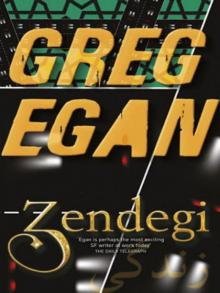 Zendegi
Zendegi Permutation City
Permutation City The Eternal Flame
The Eternal Flame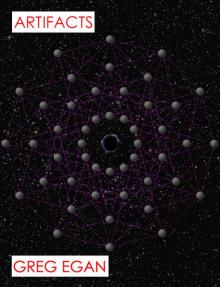 Artifacts
Artifacts Wang's Carpets
Wang's Carpets Dichronauts
Dichronauts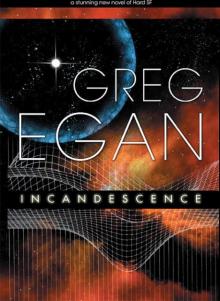 Incandescence
Incandescence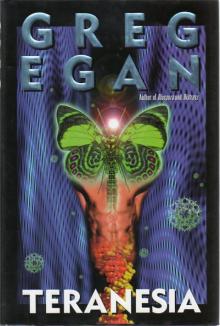 Teranesia
Teranesia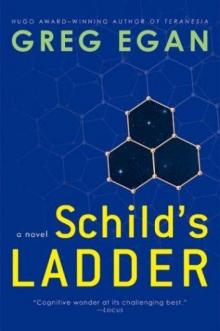 Schild's Ladder
Schild's Ladder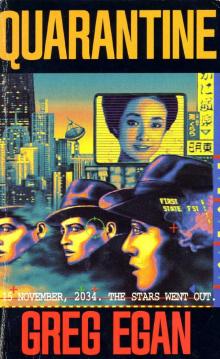 Quarantine
Quarantine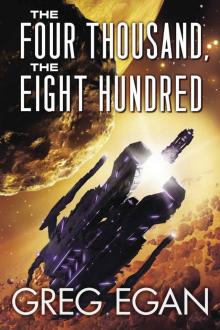 The Four Thousand, the Eight Hundred
The Four Thousand, the Eight Hundred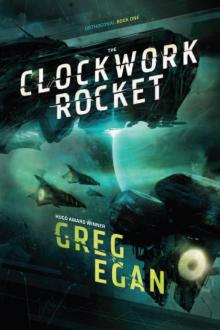 The Clockwork Rocket
The Clockwork Rocket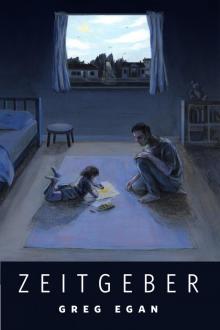 Zeitgeber
Zeitgeber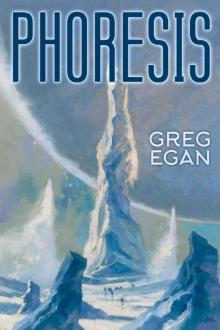 Phoresis
Phoresis The Nearest
The Nearest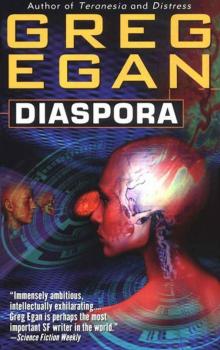 Diaspora
Diaspora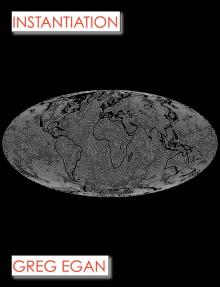 Instantiation
Instantiation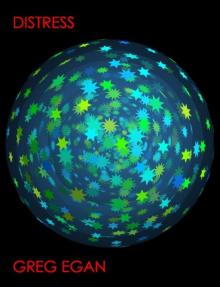 Distress
Distress An Unusual Angle
An Unusual Angle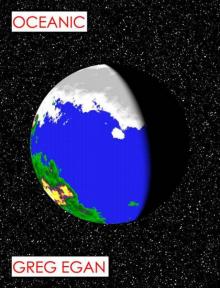 Oceanic
Oceanic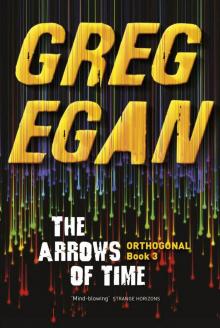 The Arrows of Time
The Arrows of Time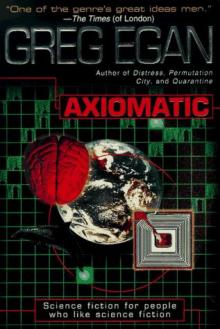 Axiomatic
Axiomatic![Anthology 2. Luminous [1998, 2010] Read online](http://i1.bookreadfree.com/i/03/18/anthology_2_luminous_1998_2010_preview.jpg) Anthology 2. Luminous [1998, 2010]
Anthology 2. Luminous [1998, 2010]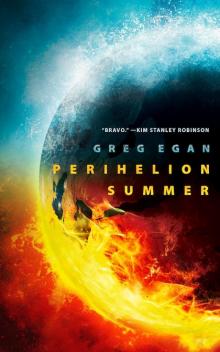 Perihelion Summer
Perihelion Summer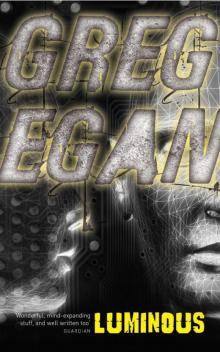 Luminous
Luminous